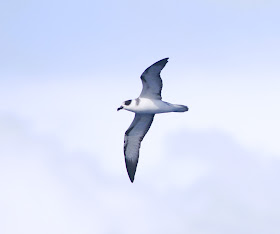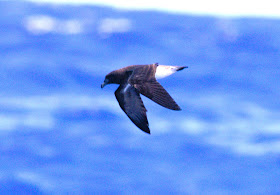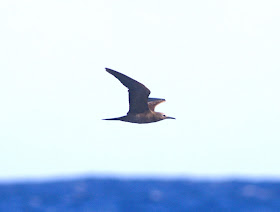 |
| Band-rumped Storm-Petrel |
Highlights of the 3-night, 2-day Southport Seamounts trip organised
by Paul Walbridge from February 9-12 included Band-rumped
Storm-Petrel; a Collared Petrel; good numbers of Gould’s Petrel,
Black-winged Petrel and White-necked Petrel; and huge numbers of
Grey-faced Petrel. After leaving early Friday evening aboard the cosy Grinner II we
ended up mid-morning at 27.3735S, 155.0996E, 100 nautical miles
offshore in 228 fathoms on the Queensland Seamount - roughly in a
line east of Pt Lookout, North Stradbroke Island. We remained in this
general area over the weekend, with some time spent motoring back
from drifting. Conditions varied little over our time out wide:
strong winds 18-25 knots SE gusting to 30 knots with a 2.5m swell and
choppy seas. A tad uncomfortable but good conditions for seabirds.
 |
| Grey-faced Petrel feeding frenzy |
Paul’s full report is forthcoming.
Suffice here to sum up some highlights. A Band-rumped Storm-Petrel flew in early afternoon on Saturday and appeared to be much attracted
to toy floating storm-petrels that Jacob Crisp had put together. It
showed well, hanging around the back of the boat for 20 minutes or
so.
 |
| Band-rumped Storm-Petrel |
 |
| Band-rumped Storm-Petrel |
Jacob got onto a decent pale phase
Collared Petrel which I saw briefly but his were the only images, and
nobody else saw the bird unfortunately. I had seen the species
previously in the eastern Coral Sea. It's a rarely encountered taxa with a few records in south-east Queensland. A couple of dark Gould’s-type
petrels also looked like contenders for a while. Gould’s Petrels
were frequently about the boat and it was a delight to see so many.
 |
| Gould's Petrel |
 |
| Gould's Petrel |
 |
| Gould's Petrel |
Black-winged Petrels were in fewer
number than Gould’s but more inclined to offer nice, close fly-bys.
 |
| Black-winged Petrel |
 |
Black-winged Petrel
|
 |
| Black-winged Petrel |
Like most seabirds over the weekend,
there was a substantial appetite for the berley. Grey-faced Petrels
were particularly voracious. This was the most common species by far,
with over 50-100 birds often in the vicinity of the boat. Large
numbers continued to be about even after sunset.
 |
| Grey-faced Petrel |
 |
| Grey-faced Petrel |
 |
| Grey-faced Petrel |
White-necked Petrel performed
beautifully, with at least 8 birds logged including 2 together. This
is a cracker of a seabird that never disappoints.
 |
| White-necked Petrel |
 |
| White-necked Petrel |
 |
| White-necked Petrel |
Kermadec Petrel was in reasonable
numbers with dark, pale and intermediate phases on show.
 |
| Kermadec Petrel (dark phase)l |
 |
| Kermadec Petrel (light phase) |
 |
| Kermadec Petrel (intermediate phase) |
Tahiti Petrel was the second most
common species, with small numbers of birds about the boat throughout
the weekend.
 |
| Tahiti Petrel |
 |
| Tahiti Petrel |
White-bellied Storm-Petrel put in a
brief appearance on a few occasions, but there was no sign of the
hoped-for New Caledonian Storm-Petrel.
 |
| White-bellied Storm-Petrel |
 |
| White-bellied Storm-Petrel |
Wedge-tailed Shearwater was relatively
common but just a handful of Flesh-footed Shearwaters appeared.
 |
| Flesh-footed Shearwater |
White-tailed Tropicbird was seen twice
flying high. A single Red-tailed Tropicbird was near the boat at
dusk.
 |
| White-tailed Tropicbird |
A Red-footed Booby roosted on the boat
on Saturday night and joined by a second bird in the morning.
 |
| Red-footed Booby |
Adult and immature Sooty Terns were
frequent visitors to the berley trail.
 |
| Sooty Tern |
A few Brown Noddies were seen along
with a single Black Noddy.
 |
| Brown Noddy |
SPECIES LIST: Tahiti Petrel,
Grey-faced Petrel, Kermadec Petrel, White-necked Petrel, Collared
Petrel, Gould’s Petrel, Wedge-tailed Shearwater, Flesh-footed
Shearwater, White-bellied Storm-Petrel, Band-rumped Storm-Petrel,
Red-tailed Tropicbird, White-tailed Tropicbird, Red-footed Booby.
Brown Noddy, Black Noody, Sooty Tern. 16 species




























No comments:
Post a Comment